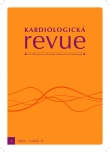Surgical treatment of atrial fibrillation
Authors:
P. Němec
Authors‘ workplace:
Centrum kardiovaskulární a transplantační chirurgie, Brno
Published in:
Kardiol Rev Int Med 2009, 11(1): 8-10
Overview
Surgical treatment of atrial fibrillation. The interest about the atrial fibrillation (AF) treatment has been increased due to its’ importance as the most common cardiac arrhytmia. It occurs mainly in two groups of patients. There are older patients and patients with left ventricular dysfunction. The history of the surgical treatment of AF is more than 20 years long. The result of this long development is the “maze” operation. It consists of the system of linear transmural lesions on the atria. Their aim is to eliminate the ectopic activity and the interruption of the re‑entry circuits which are necessary for occurrence and maintenance of the sinus rhythm. The lesion can be performed surgically (cut-and-sew technique) or by means of alternative energy sources. The sinus rhythm is maintained in about 75–80% of patients after surgical treatment. But according to the literature the results are quite variable because of different conditions. The main parameters, which contribute to this difference are: character of the atrial fibrillation (paroxysmal persistent or permanent), the length of the permanent fibrillation, the size of the atria, the original heart disease and the extend of the surgical procedure (from pulmonary vein isolation to complex lesions on both atria).
Keywords:
atrial fibrillation – surgical treatment – maze operation
Sources
1. Guiraudon GM, Klein GJ, Guiraudon CM et al. Treatment of atrial fibrillation: preservation of sinoventricular impulse conduction: the Corridor operation. In: Olsson SB, Allessie MA, Campbell RWF (eds). Atrial fibrillation: Mechanisms and Therapeutic strategies. Armonk, NY: Futura Publishing Co 1994: 349–371.
2. Guiraudon GM. Surgical treatment of atrial fibrillation. Herz 1993; 18: 51–59.
3. Defauw JJ, Guiraudon GM, van Hemel NM et al. Surgical therapy of paroxysmal atrial fibrillation with the “corridor” operation. Ann Thorac Surg 1992; 53: 564–570.
4. Cox JL, Schuessler RB, D‘Agostino HJ Jr et al. The surgical treatment of atrial fibrillation. III. Development of a definitive surgical procedure. J Thorac Cardiovasc Surg 1991; 101: 569–583.
5. Haissaguerre M, Jais P, Shah DC et al. Spontaneous initiation of atrial fibrillation by ectopic beats originating in the pulmonary veins. N Engl J Med 1998; 339: 659–666.
6. Damiano RJ Jr, Gaynor SL. Atrial fibrillation ablation during mitral valve surgery using the Atricure device. Oper Tech Thorac Cardiovasc Surg 2004; 9: 24–33.
7. Melby SJ, Lee AM, Zierer A et al. Atrial fibrillation propagates through gaps in ablation lines: Implications for ablative treatment of atrial fibrillation. Heart Rhythm 2008; 5: 1296–1301.
8. Wolf RK, Schneegerger EW, Osterday R et al. Video-assisted bilateral pulmonary vein isolation and left atrial appendage exclusion for atrial fibrillation. J Thorac Cardiovasc Surg 2005; 130: 797–802.
9. Melby SJ, Zierer A, Bailey MS et al. A New Era in the Surgical Treatment of Atrial Fibrillation. The Impact of Ablation Technology and Lesion Set on Procedural Efficacy. Ann Surg 2006; 244: 583–592.
10. Onorati F, Curcio A, Santarpino G et al. Routine ganglionic plexi ablation during Maze procedure improves hospital and early follow‑up results of mitral surgery. J Thorac Cardiovasc Surg 2008; 136: 408–418.
11. Gaynor SL, Schuessler RB, Bailey MS et al. Surgical treatment of atrial fibrillation: Predictors of late recurrence. J Thorac Cardiovasc Surg 2005; 129: 104–111.
12. Imai K, Sueda T, Orihashi K et al. Clinical analysis of results of a simple left atrial procedure for chronic atrial fibrillation. Ann Thorac Surg 2001; 71: 577–581.
13. García-Villarreal OA, Rodriguez H, Treviňo A et al. Left atrial reduction and mitral valve surgery: The “functional-anatomic unit” concept. Ann Thorac Surg 2001; 71: 1044–1045.
14. Marui A, Saji Y, Nishina T et al. Impact of left atrial volume reduction concomitant with atrial fibrillation surgery on left atrial geometry and mechanical function. J Thorac Cardiovasc Surg 2008; 135: 1297–1305.
15. Gaita F, Riccardi R, Caponi D et al. Linear cryoablation of the left atrium versus pulmonary vein cryoisolation in patients with permanent atrial fibrillation and valvular heart disease: correlation of electroanatomic mapping and long‑term clinical results. Circulation 2005; 111: 136–142.
16. Isobe N, Taniguchi K, Oshima S et al. Left atrial appendage outflow velocity is superior to conventional criteria for predicting of maintenance of sinus rhythm after simple cryoablation of pulmonary vein orifices. Circ J 2005; 69: 446–451.
17. Doukas G, Samani NJ, Alexiou C et al. Left atrial radiofrequency ablation during mitral valve surgery for continuous atrial fibrillation: a randomized controlled trial. JAMA 2005; 294: 2323–2329.
18. Deneke T, Khargi K, Grewe PH et al. Left atrial versus bi-atrial. Maze operation using intraoperatively cooled-tip radiofrequency ablation in patients undergoing open-heart surgery: safety and efficacy. J Am Coll Cardiol 2002; 39: 1644–1650.
19. Golovchiner G, Mazur A, Kogan A et al. Atrial flutter after surgical radiofrequency ablation of the left atrium for atrial fibrillation. Ann Thorac Surg 2005; 79: 108–112.
20. Khargi K, Keyhan-Falsafi A, Hutten BA et al. Surgical treatment of atrial fibrillation: a systematic review. Herzschrittmacherther Elektrophysiol 2007; 18: 68–76.
21. Neužil P, Černý Š, Pirk J et al. Operace MAZE: Jaká je realita chirurgické léčby fibrilace síní v České republice? Cor Vasa 2007; 49: 67–70.
Labels
Paediatric cardiology Internal medicine Cardiac surgery CardiologyArticle was published in
Cardiology Review

2009 Issue 1
Most read in this issue
- Ischemia-reperfusion injury following cardiac arrest and protective effects of hypothermia
- Surgical treatment of atrial fibrillation
- Current issues in resynchronization therapy of patients with heart failure
- Do we have sufficient evidence in 2009 to decide whether to implant biventricular pacemaker or cardioverter-defibrillator to cardiac resynchronization therapy patients?
